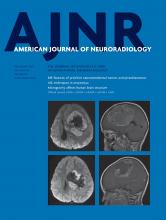Table of Contents
Perspectives
Radiology-Pathology Correlation
General Contents
- Incidental Brain MRI Findings in Children: A Systematic Review and Meta-Analysis
Seven studies were included, reporting 5938 children (mean age, 11.3 ± 2.8 years). Incidental findings were present in 16.4% of healthy children, intracranial cysts being the most frequent (10.2%). Nonspecific white matter hyperintensities were reported in 1.9%, Chiari I malformation was found in 0.8%, and intracranial neoplasms were reported in 0.2%. In total, the prevalence of incidental findings needing follow-up was 2.6%. The prevalence of incidental findings is much more frequent in children than previously reported in adults, but clinically significant incidental findings were present in <1 in 38 children.
- Comparison of CBF Measured with Combined Velocity-Selective Arterial Spin-Labeling and Pulsed Arterial Spin-Labeling to Blood Flow Patterns Assessed by Conventional Angiography in Pediatric Moyamoya
This study assesses the accuracy of combined velocity-selective arterial spin-labeling and traditional pulsed arterial spin-labeling CBF measurements in pediatric Moyamoya disease, with comparison with blood flow patterns on conventional angiography. Twenty-two neurologically stable pediatric patients with Moyamoya disease and 5 asymptomatic siblings without frank Moyamoya disease were imaged with velocity-selective arterial spin-labeling, pulsed arterial spin-labeling, and DSA (patients). Qualitatively, velocity-selective arterial spin-labeling perfusion maps reflect the DSA parenchymal phase, regardless of postinjection timing. Conversely, pulsed arterial spin-labeling maps reflect the DSA appearance at postinjection times closer to pulsed arterial spin-labeling postlabeling delay, regardless of vascular phase. ASPECTS comparison showed excellent agreement between arterial spin-labeling and DSA, suggesting velocity-selective arterial spin-labeling and pulsed arterial spin-labeling capture key perfusion and transit delay information, respectively. Velocity-selective arterial spin-labeling offers a powerful approach to image perfusion in pediatric Moyamoya disease due to transit delay insensitivity.
- Evaluation of Lower-Dose Spiral Head CT for Detection of Intracranial Findings Causing Neurologic Deficits
Projection data from 83 patients undergoing unenhanced spiral head CT for suspected neurologic deficits were collected. A routine dose was obtained using 250 effective mAs and iterative reconstruction. Lower-dose configurations were reconstructed (25-effective mAs iterative reconstruction, 50-effective mAs filtered back-projection and iterative reconstruction, 100-effective mAs filtered back-projection and iterative reconstruction, 200-effective mAs filtered back-projection). Three neuroradiologists circled findings, indicating diagnosis, confidence, and image quality. The routine-dose jackknife alternative free-response receiver operating characteristic figure of merit was 0.87. Noninferiority was shown for 100-effective mAs iterative reconstruction and 200-effective mAs filtered back-projection, but not for100-effective mAs filtered back-projection. The authors conclude that substantial opportunity exists for dose reduction using spiral nonenhanced head CT and that the dose level might potentially be reduced to 40% of routine dose levels or a volume CT dose index of approximately 15mGy if slight decreases in performance are acceptable. The beneficial effect of iterative reconstrution was most pronounced at this 15-mGy dose level.
- Prolonged Microgravity Affects Human Brain Structure and Function
Brain MR imaging scans of National Aeronautics and Space Administration astronauts were retrospectively analyzed to quantify pre- to postflight changes in brain structure. Local structural changes were assessed using the Jacobian determinant. Structural changes were compared with clinical findings and cognitive and motor function. Long-duration spaceflights aboard the International Space Station, but not short-duration Space Shuttle flights, resulted in a significant increase in the percentage of total ventricular volume change (10.7% versus 0%). The percentage of total ventricular volume change was significantly associated with mission duration but negatively associated with age. Pre- to postflight structural changes of the left caudate correlated significantly with poor postural control, and the right primary motor area/midcingulate correlated significantly with a complex motor task completion time. These findings suggest that brain structural changes are associated with changes in cognitive and motor test scores and with the development of spaceflight-associated neuro-optic syndrome.
- Hemodynamic Analysis of Postoperative Rupture of Unruptured Intracranial Aneurysms after Placement of Flow-Diverting Stents: A Matched Case-Control Study
The authors enrolled 10 patients with intracranial aneurysms, treated with flow diverters between September 2014 and December 2018, who experienced postoperative aneurysm rupture. They matched these subjects 1:2 with 20 with postoperative unruptured intracranial aneurysms based on clinical and morphologic factors. Using computational fluid dynamics, they assessed hemodynamic changes pre- and posttreatment between the 2 groups on a number of qualitative and quantitative parameters. Compared with pretreatment, unstable flow pattern and higher energy loss after Pipeline Embolization Device placement for intracranial aneurysm may be the important hemodynamic risk factors related to delayed aneurysm rupture.
- Armed Kyphoplasty: An Indirect Central Canal Decompression Technique in Burst Fractures
This study assesses the results of armed kyphoplasty using vertebral body stents or the SpineJack in traumatic, osteoporotic, and neoplastic burst fractures with respect to vertebral body height restoration and correction of posterior wall retropulsion. The authors performed a retrospective assessment of 53 burst fractures with posterior wall retropulsion and no neurologic deficit in 51 consecutive patients treated with armed kyphoplasty. Posterior wall retropulsion and vertebral body height were measured on pre- and postprocedural CT. Armed kyphoplasty was performed as a stand-alone treatment in 43 patients, combined with posterior instrumentation in 8 and laminectomy in 4. Pre-armed kyphoplasty and post-armed kyphoplasty mean posterior wall retropulsion was 5.8 and 4.5 mm, respectively, and mean vertebral body height was 10.8 and 16.7 mm, respectively. They conclude that in the treatment of burst fractures with posterior wall retropulsion and no neurologic deficit, armed kyphoplastyyields fracture reduction, internal fixation, and indirect central canal decompression.
35 Years Ago in AJNR
Online Features
Letters








